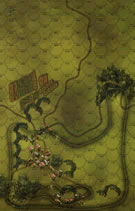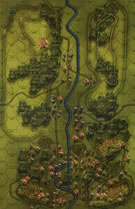|
Returned Across the Sea Polish Steel #1 |
||
|---|---|---|
| (Attacker) Poland | vs | Soviet Union (Defender) |
| Formations Involved | ||
|---|---|---|
| Poland |  |
16th Armoured Brigade |
| Poland |  |
4th Infantry Division |
| Soviet Union |  |
15th Rifle Division |

| Total | |
|---|---|
| Side 1 | 1 |
| Draw | 0 |
| Side 2 | 0 |
| Overall Rating, 1 vote |
|---|
|
4
|
| Scenario Rank: --- of 913 |
| Parent Game | Polish Steel |
|---|---|
| Historicity | Alt-History |
| Date | 1948-07-01 |
| Start Time | 06:00 |
| Turn Count | 26 |
| Visibility | Day |
| Counters | 138 |
| Net Morale | 1 |
| Net Initiative | 2 |
| Maps | 2: 27, 30 |
| Layout Dimensions | 56 x 43 cm 22 x 17 in |
| Play Bounty | 187 |
| AAR Bounty | 171 |
| Total Plays | 1 |
| Total AARs | 1 |
| Battle Types |
|---|
| Exit the Battle Area |
| Inflict Enemy Casualties |
| Conditions |
|---|
| Entrenchments |
| Off-board Artillery |
| Terrain Mods |
| Scenario Requirements & Playability | |
|---|---|
| Cassino '44 | Counters |
| Fall of France 1 | Maps |
| Polish Steel | Base Game |
| Road to Berlin | Counters |
| Introduction |
|---|
|
Soon after the disastrous American attempt to break the Berlin Blockade in June 1948, Soviet armored spearheads struck into the American and British Occupation Zones in western Germany. The withdrawal of US forces three years earlier to the lines agreed upon at Yalta gave the Soviets a ready-made salient from which to attack the British and Americans simultaneously. The British caught the worst of it and were driven back to the North Sea coast, with the port of Wilhelmshaven dubbed "The New Dunkirk" but holding out better than its predecessor due to its protected position on the Jadebusen. That gave the recently demobilized Polish I Corps time to muster in Britain and ship out to Wilhemshaven, a port which they had captured during the war and occupied until their departure. Having always been equipped with a wide variety of British tank models, the men of I Corps had eagerly trained with the new British heavy tanks that rolled off the assembly lines and into occupied Germany after the war. They were therefore able to jump right off the boats and down the hatches of waiting tanks as the Poles massed for the breakout effort against the Red Army fores investing Wilhelmshaven. |
| Conclusion |
|---|
|
Polish soldiers fought for six years to liberate their homeland, shedding their blood in Africa, Italy, France and the Soviet Union only yo be betrayed at Yalta. Bitterness abounded in the veterans of the Polish exile formations, but could any of them pass up a chance to try to free their homeland? |
| AFV Rules Pertaining to this Scenario's Order of Battle |
|---|
|
| 2 Errata Items | |
|---|---|

|
The reduced direct fire value in Kursk: Burning Tigers is 4-4. (plloyd1010
on 2015 Jul 31)
|

|
Kommissars never get morale or combat modifiers. Ignore misprints. (Shad
on 2010 Dec 15)
|
| It was a fight for two hours |
|---|
|
In this scenario a large Polish armored force with some nasty Black Princes and even nastier Crocs and AVREs need to break through an RKKA defense loaded with AA, AT and tank destroyer support. The goal of the Poles is to break the crust and run for the exits. The Soviets want the Poles to stick around awhile. Unfortunately for the Soviets they just don't have the oomph to hold the Poles in place. The Soviets see that the shortest route for the Poles is through the rural south end of the board and decide to place the majority of their serious weaponry there with belts of mines fronting them. They deploy a company of infatry with engineer support in the northern, more urban end of the board but also provide them with transport (trucks) to be able to move rapidly should the Poles ignore them. The Poles, as projected approach the river with their weight in the south, cross the river and engage the entrenched Soviets. The early fighting greatly favors the Soviets and in the first hour step losses are 9-2 in their favor with heavy losses amongst the Polish engineers (note that the river is minor with no bridges - merely slowing down the Polish leg and mechanized forces but forming a complete boundary for the 17 pdrs as the only transport is motorized). After shaking off the early losses the Poles get down to business on the Soviet first line, destroying 16 steps plus both steps of SU-100s in the next hour while losing only 3 steps and 1 step of Black Princes. After this it was merely a matter of cleaning up the battlefield. By the time turn 18 had finished the Poles had already exited 18 steps and had a 50 point lead in the scenario. Despite the lopsided result I enjoyed the play quite a bit. The opporutunity to use these weapons in a scenario where the Poles have to move on is a blast. I anticipate a similar feeling with the scenarios in Patton's Nightmare as well as the upcoming Hammer & Sickle. The scenarios are typically large (this is one of the smaller ones) and have a variety of types of engagements. I give this one a "4" and look forward to the rest. |
| 0 Comments |

 PoEx015
PoEx015 






























